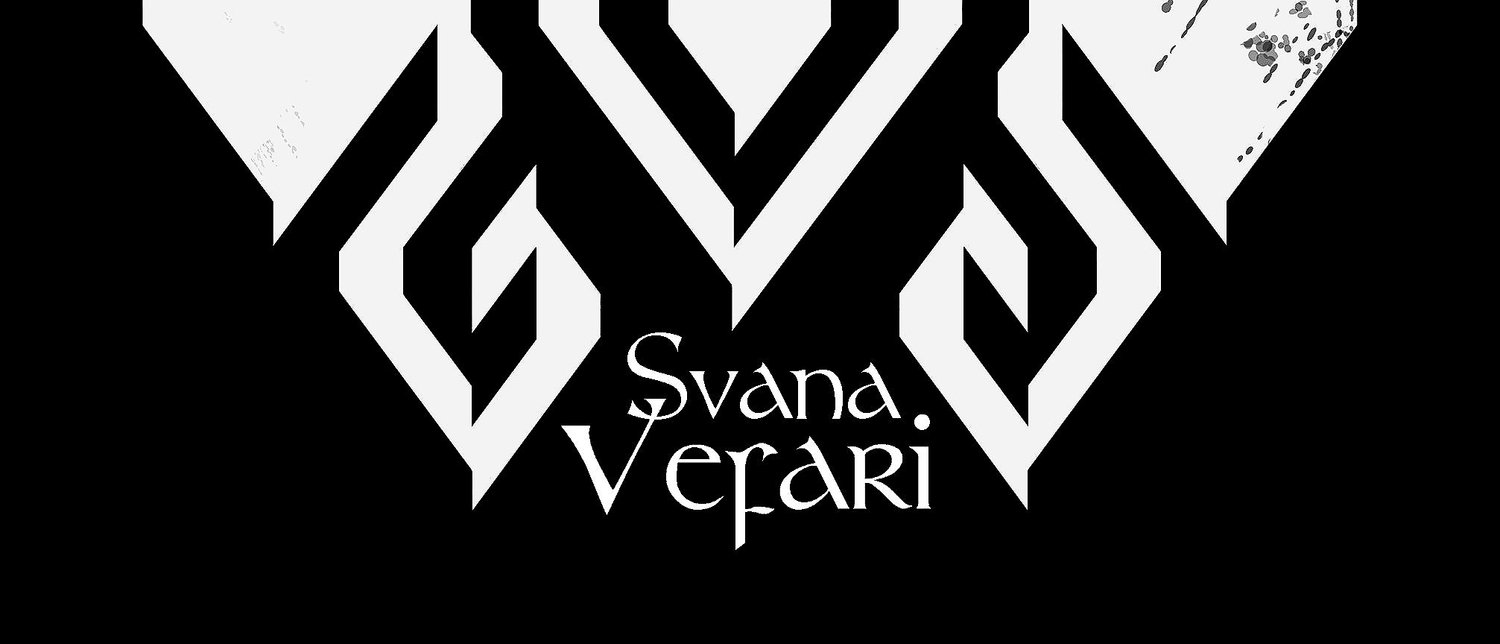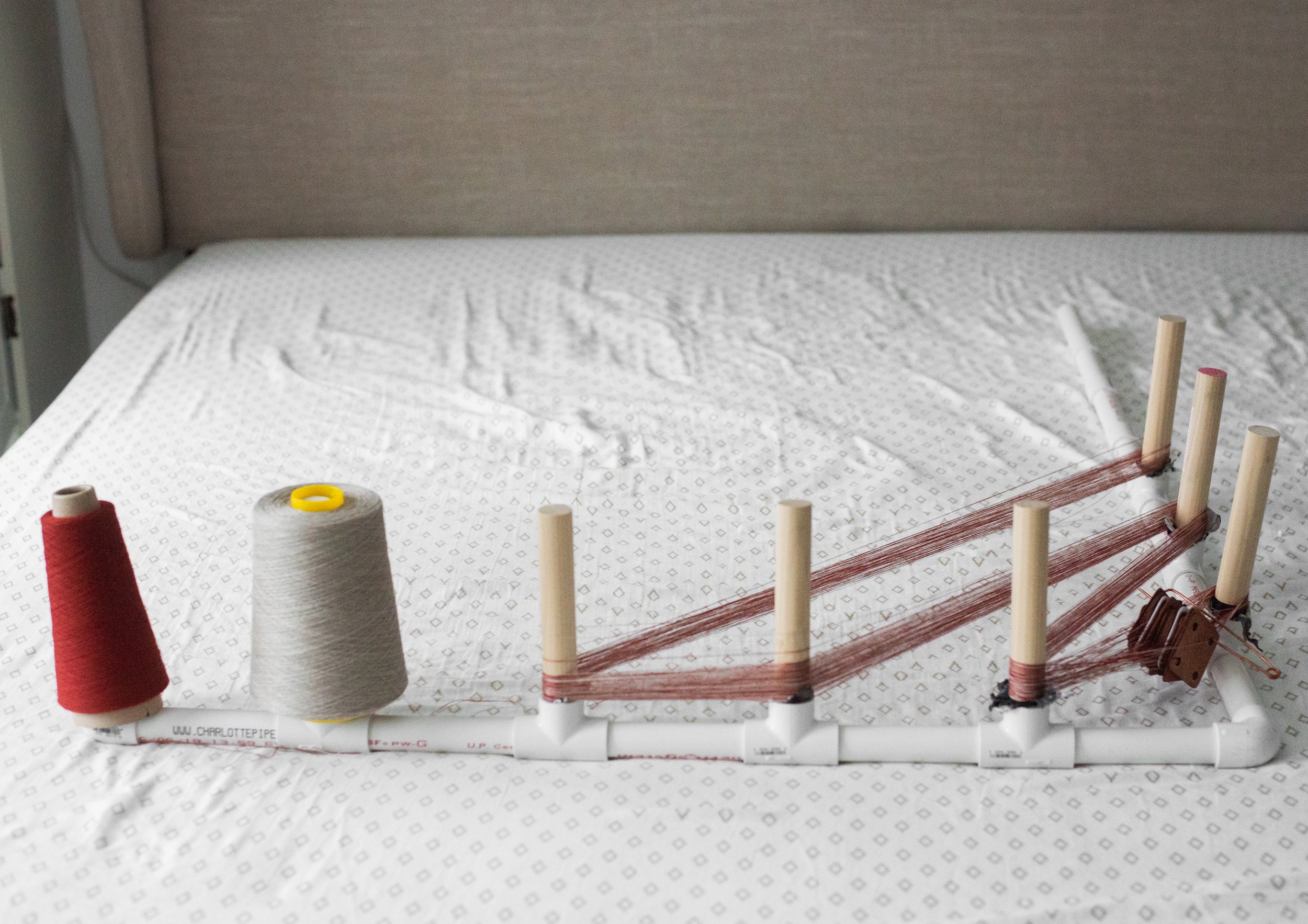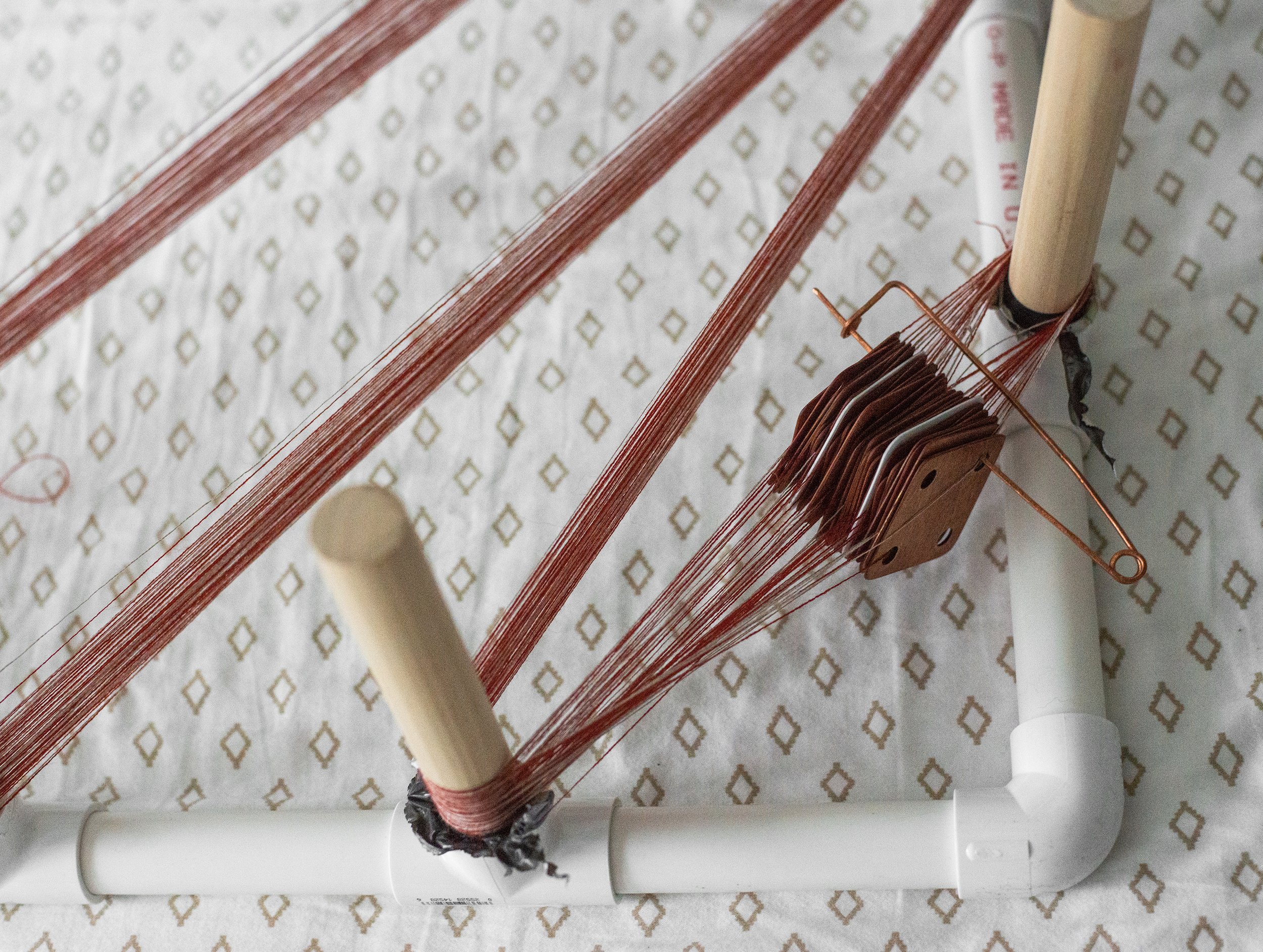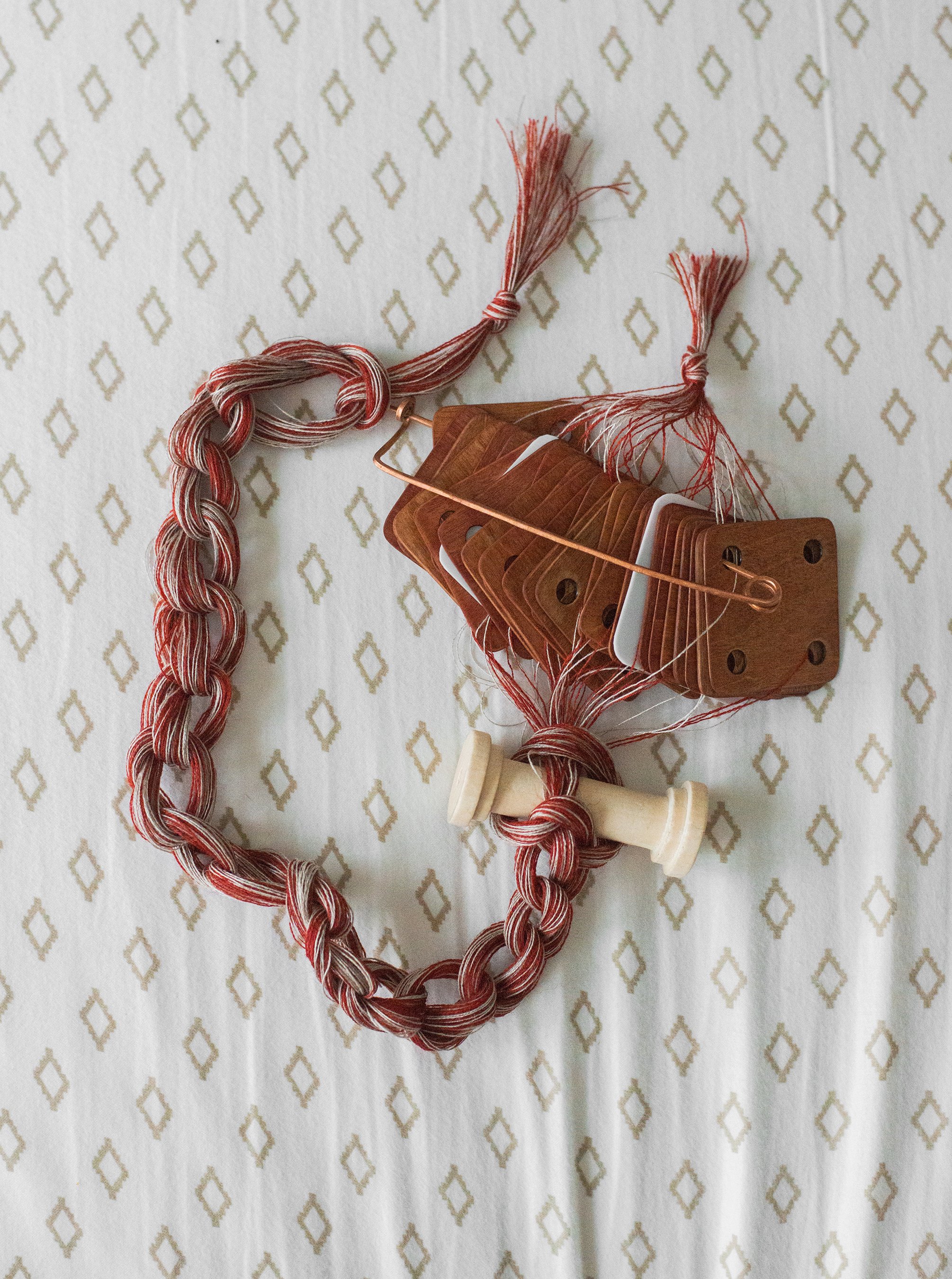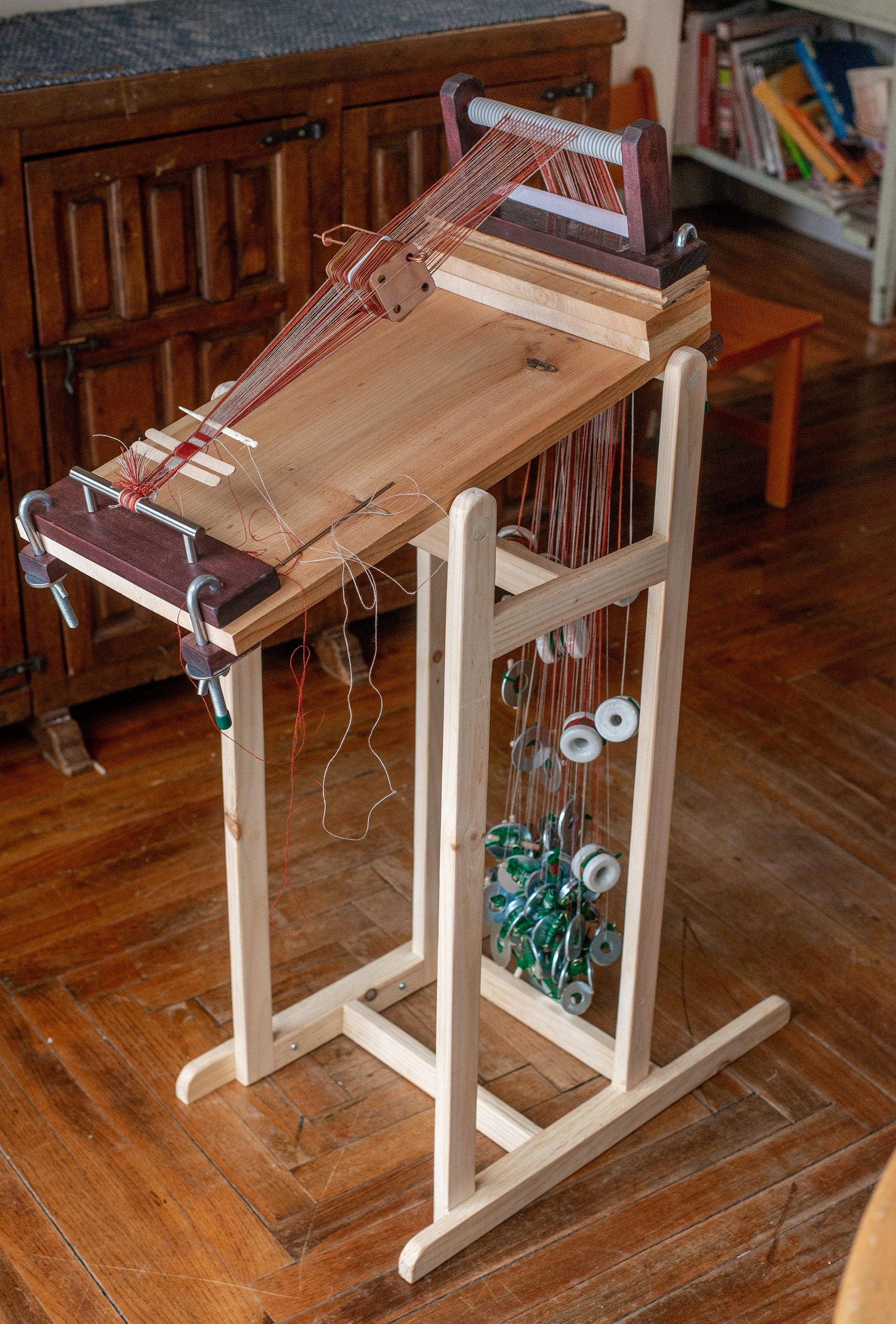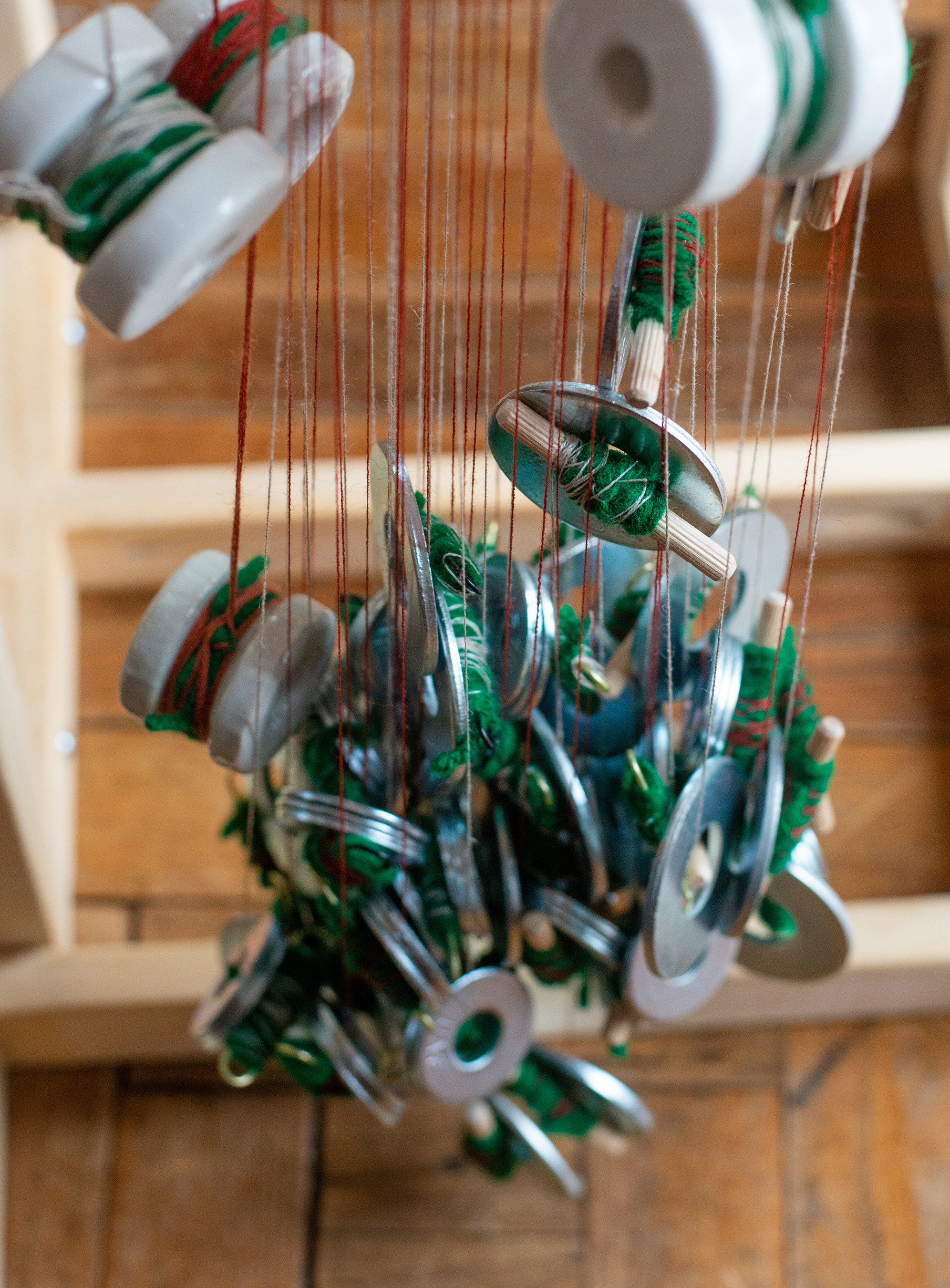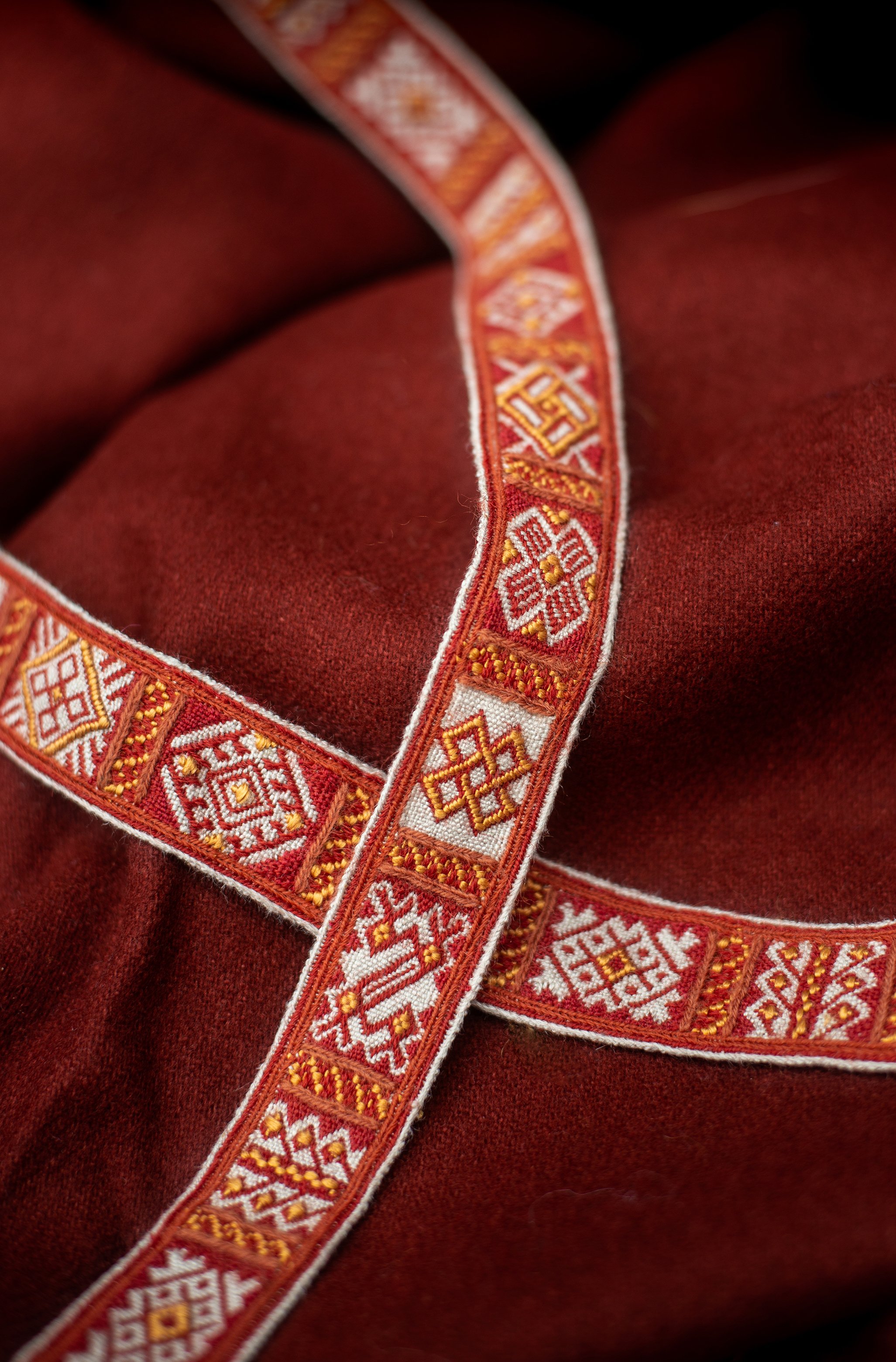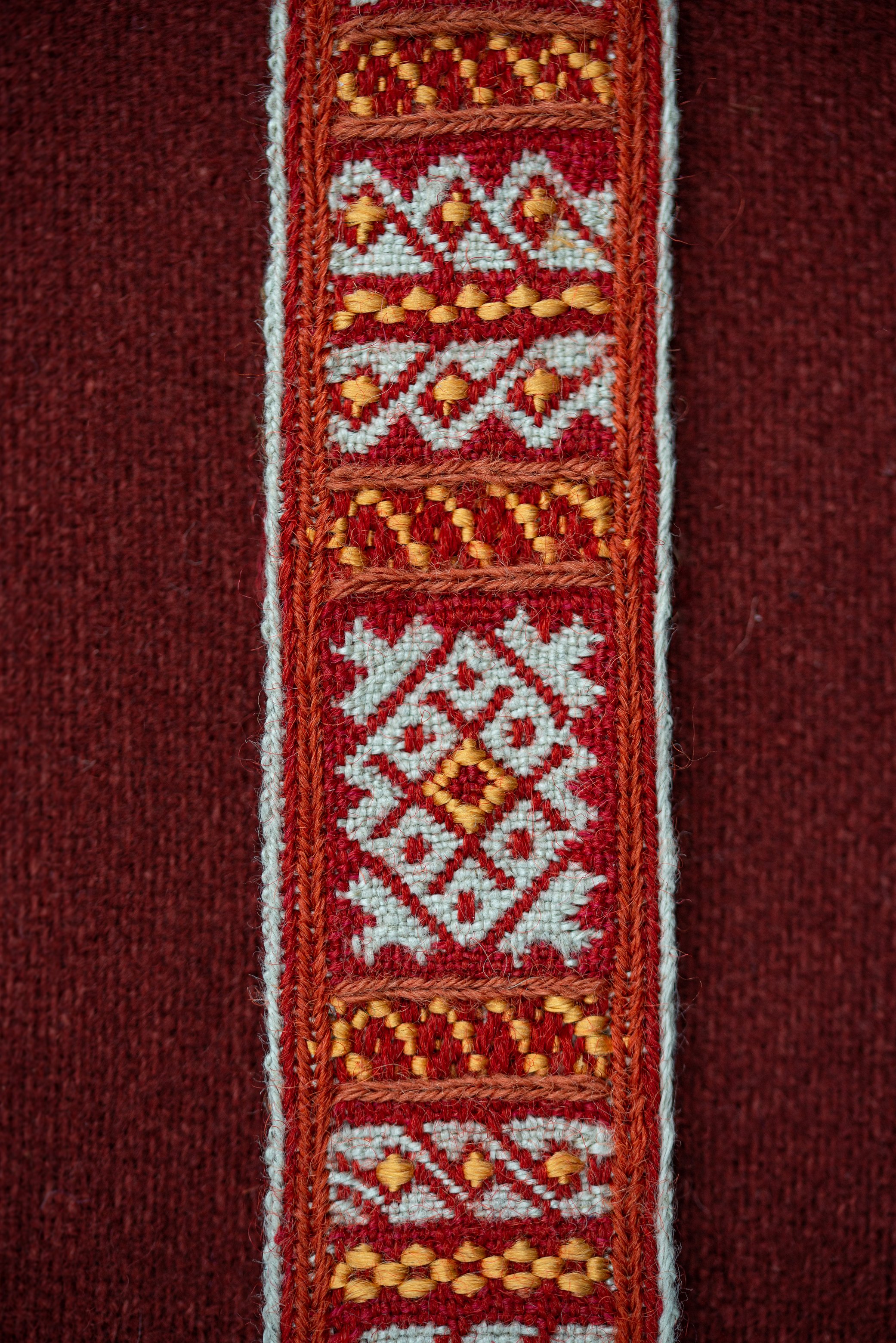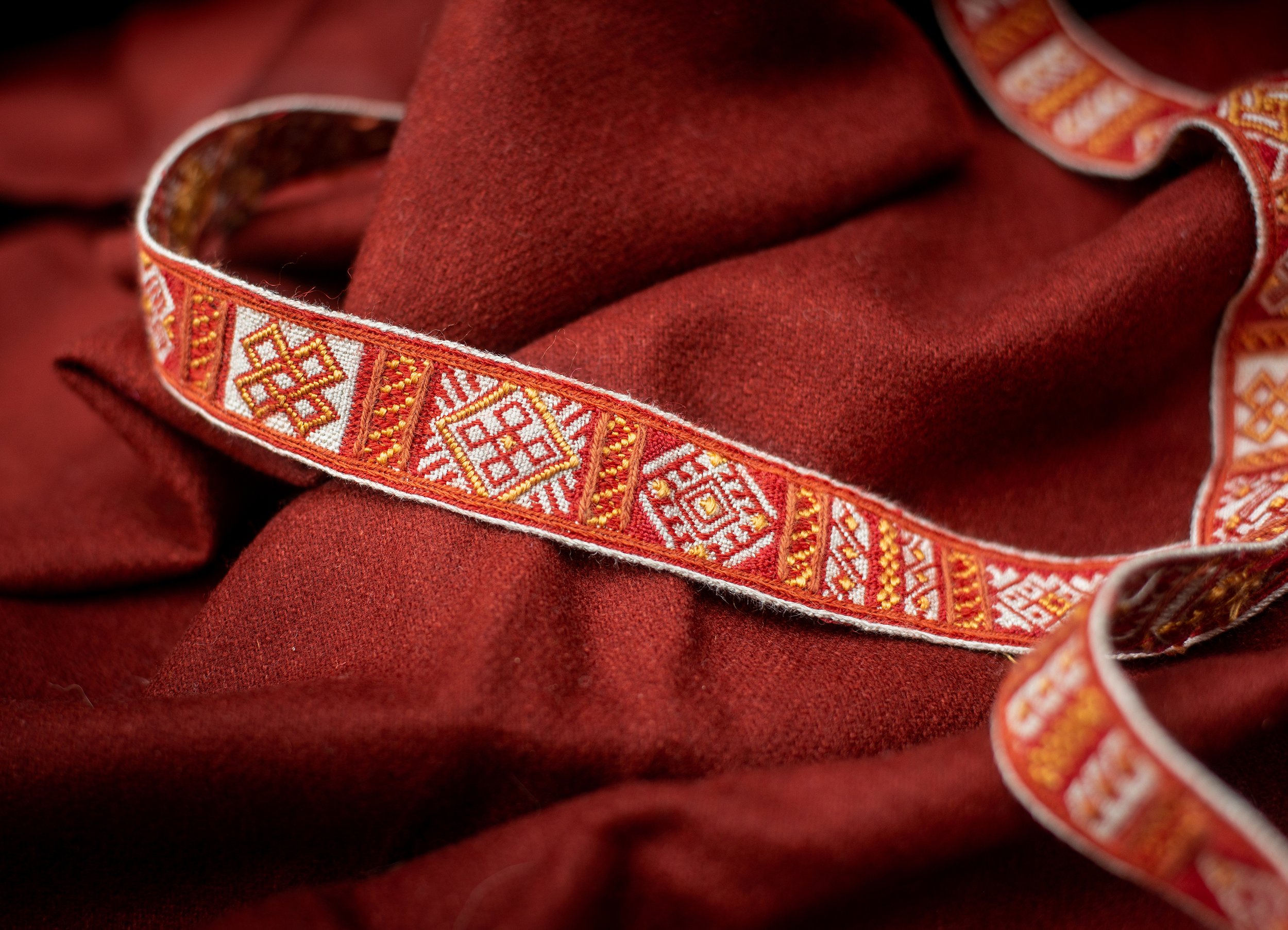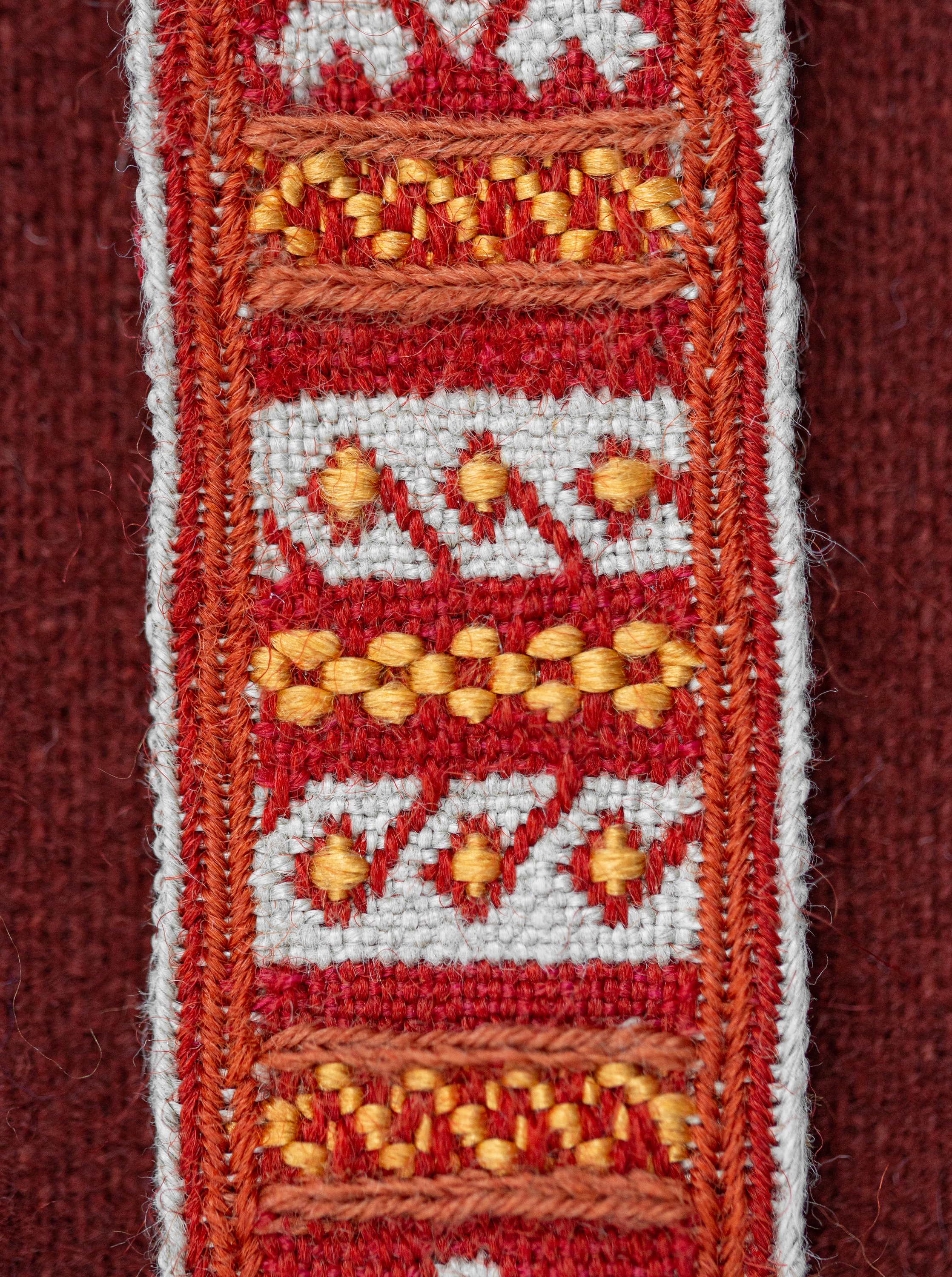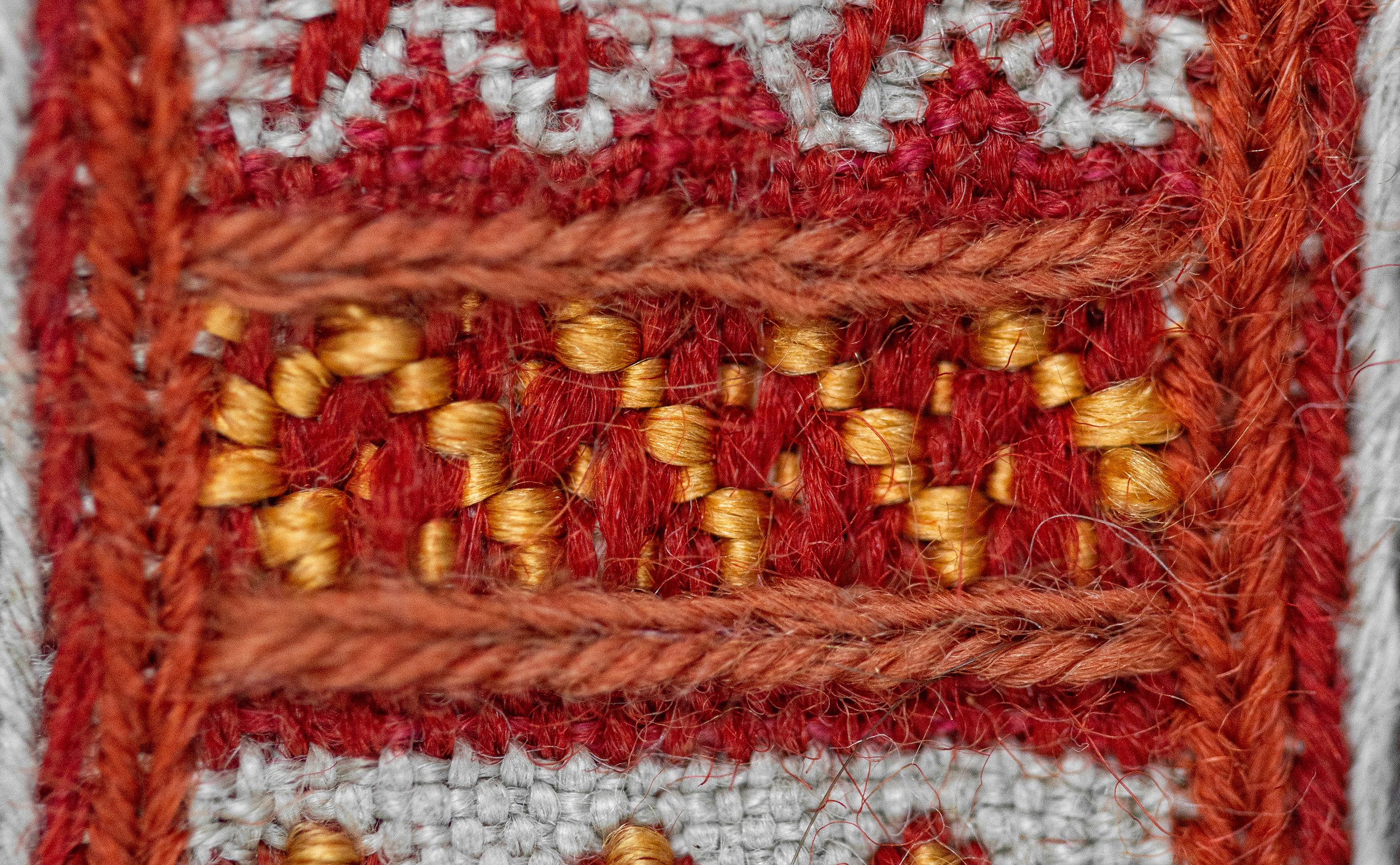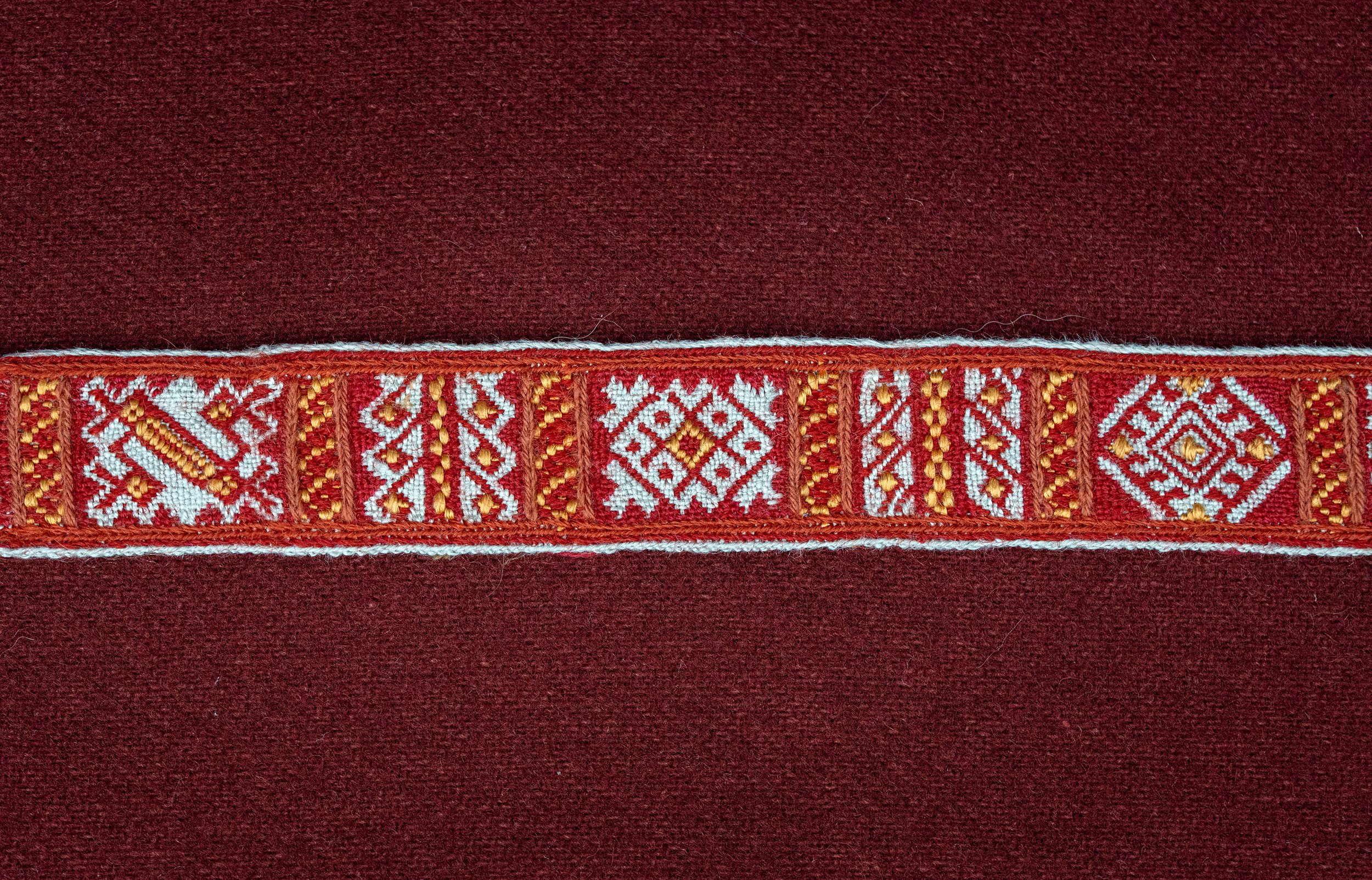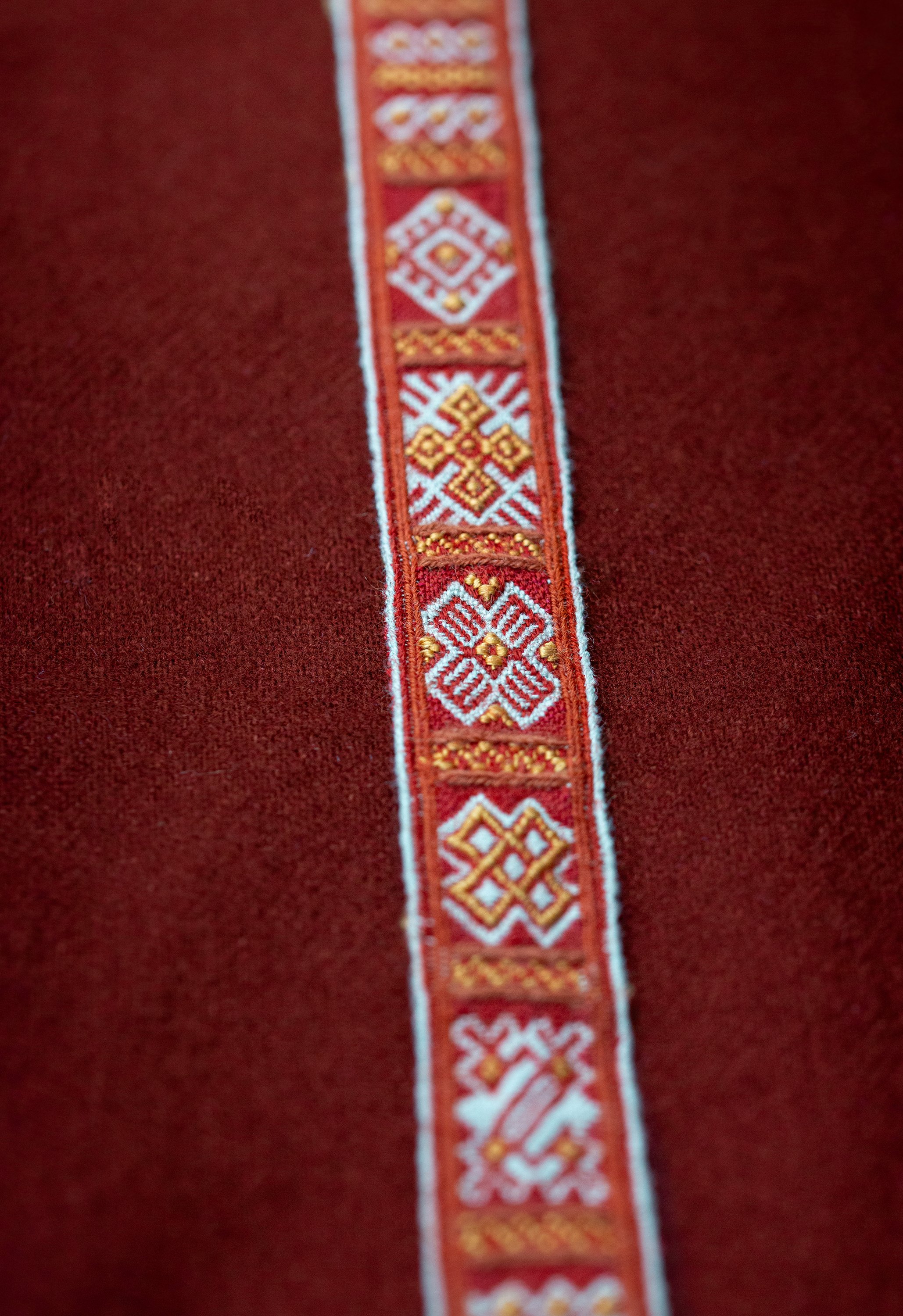Oseberg 34D
A Tablet Woven Band from 834 AD
Category: Fiber Arts, Weaving
Oseberg 34D is one of 52 tablet woven bands excavated from an impressive ship burial found in Oseberg Farm near Tonsbery, Norway. Uncovered in 1904, the ship was the final resting place for two wealthy women. Due to the extravagant amount of textiles and tapestries, weaving tools, and even a loom found within the collapsed burial chamber, it is reasonable to believe that atleast one of the women may have been an experienced weaver. An abundance of other treasures, including furniture and ornately decorated everyday objects, were also buried with the women. You can find many of these incredible artifacts exhibited within the Viking Ship Museum in Oslo. (Skogsaas, 2019) (University of Oslo)
Of the many woven bands found within the Oseberg burial, Oseberg 34D is truly unique, as it was the only band to contain areas of tabby weave, not commonly found in tablet woven bands. Other techniques used to create 34D include soumak, traditional tablet woven selvages, and brocade. (Skogsaas, 2019)
Oseberg 34D (Kulturhistorisk Museum UiO)
(Symbol of Swastika has been censored)
Oseberg 34D consists of two fragments. One fragment is 19cm long while the other is 13cm long and about 2cm wide, excluding selvages. The original length of the band is impossible to know due to its damaged ends. There are seven somewhat discernable motifs, which all appear to be tabby woven and include some amount of silk brocade and a repeating brocaded border that separates each design. Soumak, which resembles a horizontal braid, frames this border on the bottom and top. Unfortunately, one area of the band has been far too damaged to tell how its motif appeared. The ends of the band, where there were likely more woven motifs, are also too severely damaged to know how they appeared. There is one small section on the edge of the band where selvages are still attached. A traditional forward turning of the edge tablets creates these selvages. (Skogsaas, 2019)
The materials used to create this band were wool in reddish tones, loosely spun silk in a pale white or yellow color, and some type of vegetable fiber. Unfortunately, the vegetable fiber has completely decayed and is now non-existent, so it isn't possible to determine its material or color precisely. The weft thread is no longer present in the band either, suggesting it was also a vegetable fiber. (Skogsaas, 2019)
By looking at the impressions in the wool warp, left behind by the vegetable fiber, it is possible to get a somewhat accurate idea of how the motifs looked. The silk brocade also helped hold some wool warp areas together and embellished the designs.
Reconstructing 34D
It would not have been possible for me to reconstruct 34D without the extensive research published by Bente Skogsaas in her book, Oseberg 34D. Bente has been researching the band since 2015 and has documented her findings, providing beautifully detailed instructions for one to weave it. Being that I will never see this band in person or look at it under a microscope with my own eyes, having her findings and instructions available, as well as occasionally communicating with Bente over social media, has been invaluable. During my attempts to weave 34D, I made some adjustments to address issues that arose. These adjustments mainly apply to how I turned the selvages to compact the designs and prevent elongation of the motifs, which I will discuss later on.
The reconstruction I have woven is about 37.5” in length. This length allowed me to explore some possibilities in technique, and I repeated motifs many times to test any minor adjustments I made. I wove it this way to further my understanding of how Bente Skosaas wove this band and how I might make minor adjustments if any at all. Small changes I made stemmed from how I perceived photos of the original band and my own curiosity.
Technical Information
40/2 undyed linen - warp and weft
Reeled Mulberry Silk thread - Brocade
20/2 Wool Thread - Warp, weft, Soumak
I chose a reeled silk in a light golden color. The main reason for this choice was because the original band's silk appeared to be loosely spun. (Skogsaas 2019) There is a much more vibrant sheen to loosely spun silk. However, it was only used to brocade and embellish the motifs. I wonder if the original weaver opted for a looser spun silk for this reason, simply because it "shines" more.
20/2 Wool thread seemed to work well for achieving the width of the original band (2cm between the selvages). At first, this was not the case as my band began slightly more narrow than the original. However, after adjusting how I wove the selvages to address other issues, I was pleasantly surprised to see the band widen to the desired width of the original. I also think it is important that no matter what thickness of fiber you choose, the band's texture is a bit more pleasing to the eye if the wool warp thread is at least slightly thicker than the linen thread. When I wove my first 34D attempt with 40/2 linen and 28/2 wool thread, I realized this. I thought the 28/2 would be thicker than the linen, but as it turns out, it was slightly thinner, and therefore it didn't look as nice. I abandoned this first attempt after weaving eight inches and then began my second attempt with the slightly thicker wool.
No official analysis of color has been done on Oseberg 34D, but the band appears to have been some type of red color with a lighter color used for the Soumak and innermost selvages. Unfortunately, it is not possible to know what color the plant fiber was since it is no longer exists. (Skogsaas, 2019) Therefore, I chose undyed flax linen. I thought it created a nice contrast in the motifs against the red wool. Skogsaas also used this color linen in some of her reproductions, and I thought it was stunning. It’s fair to say that all thread colors I chose were achievable within the period and therefore, appropriate.
Warping
The 30 Tablets that make up the pattern area of the band are easy to warp using the continuous warp method. Each consists of one hole threaded with linen and the hole diagonally opposite that is threaded with wool. The other two holes are simply left empty. (Skogsaas, 2019) I used a homemade warping board to measure out about 54” of warp. The remnant of the original band was much smaller, but I wanted a longer warp to allow for experimentation.
The eight selvage tablets (4 tablets on either side) are threaded in all four holes, with the outermost card threaded in linen. There is no evidence that this outer linen thread existed on the original band (it would be completely decayed if it was), but having it present helps disguise the linen weft on the edge of the band. Skogsaas suggests that an experienced weaver within the period may have preferred having an outer linen warp thread for this reason, and I agree with her. The next selvage card is threaded with red wool, and the last two cards (closest to the motifs) are threaded with light orange wool, which is the same wool used for the soumak borders. Using the same wool color for the two innermost selvage cards and the Soumak was quite clever as it creates a nice frame visually around the motifs.
The warp is then chained to prevent tangling before being put on the loom. A pin is important to keep the Tablets orderly. The selvages are not depicted in these photos. I threaded them separately and added them to the loom after warping the main pattern area of 30 tablets, which is easy to do on a warp-weighted loom.
I chose to use a warp-weighted loom to help deal with the issue of varying tension between linen and wool threads. Linen thread has little to no stretch, while wool thread can have a bit of play when under tension. Typically, I would tie all the warp strings together from one single tablet to one weight. However, if I weighted a tablet containing both linen and wool threads in this way, the wool would only stretch as far as the not-so-stretchy linen thread and, therefore, wouldn’t have as much tension.
I decided to put one metal washer on each singular thread within the pattern area. This way, both the linen and wool threads are weighted individually, and the linen will not keep the wool from stretching out. In doing so, the wool threads stay under tension consistent with linen threads. For the selvages, I used a porcelain fence insulator that is slightly heavier than the flat washers. All four selvage threads from each tablet were tied to one fence insulator. Having more tension on the selvages helps to keep the edges straight. Warp weighted looms also make replacing broken warp threads easier and quicker. I only broke a handful of wool threads during the weaving process, but I was grateful for this advantage when I did.
In period, clay weights shaped like doughnuts were used to tension warp strings while weaving fabric on standing looms. (Dance) To my knowledge, there is no evidence that weights were used in this way for tablet weaving. However, the evidence of weights being used to weave fabrics in period suggests weights also being used for tablet weaving during period is within the realm of possibility.
My loom was built by myself using scrap wood and materials from the hardware store. The base of the loom extends longer in the back to prevent tipping over from the weights hanging off of the rear.
See my “Tools” list for an explanation of how each warp string was attached to its weight.
Tools
A list of tools I used to weave this band which corresponds with the provided photograph.
(A) Wooden shuttle. Usually wrapped with a length of weft thread, shuttles then carry that thread through the warp strings. However, due to the techniques used to weave this band, my weft thread was passed using other tools (see “D” and “E”). Therefore, I only used this particular shuttle to beat/compact my weft thread. It has a sharp beating edge and was long enough to grip easily on each side while pushing my weft thread down, making it ideal for this purpose.
(B) Warp Weight (metal washer with wooden dowel and acrylic leader string). Weights were commonly used in Period to tension warp threads while weaving large pieces of fabric and were typically made of stone or clay. I chose to use modern metal washers to weight my warp strings. I did so by taking each warp string and tieing it to a 15“ leader string. The leader is made from inexpensive acrylic yarn. Its purpose is to allow me to weave more of my warp when nearing its end. I then took a wooden dowel (and in some cases, a paper clip), wrapped most of a warp string around it, and then put the dowel through the middle of the washer to hang there. I used only one washer per warp string.
(C) Scissors. These scissors look very much like a pair of scissors also excavated from the Oseberg Ship burial. I enjoyed using them for this simple reason.
(D) Bone Needle. I used this large, blunt needle for the wool Soumak and Brocaded Silk sections of the Oseberg band. It was easy to handle and effectively moved in and out of the warp strings. I also love that it is made of bone as it was a material commonly used to make needles in Period.
(E) Netting Shuttle. I used two of these shuttles, one for the linen weft thread and another for the wool weft thread. I like these shuttle because they are small, about 4.5” long, and still hold a significant amount of weft thread. But their most helpful characteristic was their pointed end. This point made it easy to weave over and under the warp strings when creating the tabby woven motifs in the band.
(F) Copper Pin. Like an extra set of hands, this pin was a lifesaver (or rather, warp saver). I had to keep the tension on my warp very light to help prevent elongation of the patterns. However, the slack this creates allows the tablets to turn on their own easily. Unless I was in the process of turning the tablets myself, the pin would stay threaded through the entire pack of cards to prevent them from turning when I did not intend them to.
(G) Wooden Tablets. I used 36 of these wooden tablets and two white plastic ones (not shown). They are 2”x 2”, which I feel is an ideal tablet size to weave with, allowing a large enough shed to work with while not taking up too much reality in the weaving area. The two plastic tablets were placed in the very center of the group, making it visibly easier to pick without miscounting.
Technique
Oseberg 34D was undoubtedly a new experience with a bit of a learning curve. This band is created with four different weaving techniques that even an experienced weaver will find very challenging.
A form of weaving called Tabby creates the main pattern area. The weft passes over and under alternating warp threads to produce a Tabby weave. 34D makes this more challenging because the weaver must first turn the tablets to bring the desired warp thread, either wool or linen, to the top of the shed. In some cases, the wool warp creates floats, and the linen warp sections are Tabby woven. At other times, the wool and linen warp areas are both Tabby woven.
Here, I am practicing switching between wool and linen tabby to create geometric designs.
Soumak was also a new technique for me. It creates a beautiful horizontal border that resembles a braid, adding delightful texture and dimension to the band. It involves wrapping a thread around groups of warp threads in a particular pattern. The Soumak border is made from two passes across the band starting in opposite directions. I love this technique and look forward to applying it to personal weaving projects in the future.
Weaving Soumak with needle.
Silk Brocade is present throughout the band and is purely decorative. The brocade weft dives through the warp to the underside of the band before coming back up again to the surface.
Silk Brocade in Yellow.
Since the brocade passes through to the back of the warp, the underside of 34D can appear quite messy. The only photograph of the back of 34D was taken in 1916 and clearly shows that this side of the band was somewhat chaotic, with brocade threads jumping from one part of the band to another. For this reason, Bente Skogsaas remarks that it may have been meant to be sewn onto something, although there is no physical evidence that it was. Nevertheless, I was pleased to see that the back of my band has a similar appearance to the back of the original. Keep in mind that the back of my band shows the linen warp threads, which are no longer present on the original band.
The back of my band compared to the back of a similar motif on the original band. Bear in mind, the linen warp has decayed and is no longer visible on the original band.
Right photo: O. Voering 1916
Being threaded in all four tablet holes and continuously turned forward, the selvages are created in a very common technique amongst tablet woven bands. This is why I find it so ironic that the selvages attributed to the most significant obstacle I experienced while weaving 34D.
While looking through photos of Bente Skogsaas's 34D reproductions and other weaver's reproductions of the band, I noticed there was still slight elongation of the motifs in their weaving. When looking at the original band, you can see that the motifs are square. And why shouldn't they be? After all, they are tabby woven! Tabby Weave is usually easy to compress until square, matching the warp and weft string count per inch in both length and width. The critical thing to remember is that even though this band uses tablets, it is mainly a tabby weave that creates the patterns, unlike traditional tablet weaving, where threads twist around each other to create designs. Elongated patterns are often an issue when tablet weaving but can be helped by lessening the tension on your warp, beating your weft hard after each pass, and using a thinner weft thread. I did all of these things, and my motifs did become less elongated, but not quite enough.
I wove much of my band with slightly elongated motifs and struggled to compress them until I finally came up with a solution. As it turns out, the difference in technique between the outer selvages and the central tabby woven area creates a difference in weft spacing between the two parts. The selvages consist of four threads per tablet which twist around each other and therefore advance slightly farther each pick than the rest of the warp. As a result, the selvages hold the weft thread somewhat farther up the warp, making it hard to compact the weft down in the central pattern area so the motifs do not become elongated. I began to notice this was the case when I was compressing my weft very hard to keep my motifs less extended, resulting in my motifs becoming less long, but my selvages were uncomfortably packed tight. So much so that they kept wanting to spring back up. Quite frankly, they also didn't look very nice shoved down this way.
I didn't come up with a solution very quickly. It took a lot of weaving before the following idea came to mind. To keep the selvages from advancing out farther than the pattern area each pick, I reduced the number of turns used to create the selvages. Typically, one would turn the selvage tablets on both sides of the band forward a quarter turn each pick. Instead of doing this, I only turned the selvages forward on the side that the weft was entering the shed for that pick, and did not turn the selvages on the opposite side. Weaving this way alternates what selvages are being turned on which side every pick, making it so that each side is only turning once every two picks.
For example, if you were to begin a pick and your weft is entering into the right side of the shed and coming out on the left side, you would only turn the selvages on the right side for that pick and leave the selvage tablets alone on the left side. During the next pick, the weft would then be entering on the left side of the shed, and therefore the left selvage tablets are now turned forward, and the ones on the right are left alone this time.
Here are before and after pics. "Before" shows how compressed and "uncomfortable" the selvages look in the first picture because they are compacted far too much and want to stretch out and pull the motif up with it. The "After" shows how relaxed they are by turning them only every other pass/pick. As a result, they look much more comfortable and allow the weft in the pattern area to be compacted more, helping considerably to reduce elongation of the motif.
An unforeseen but welcomed side effect of turning the selvages in such a way was it allowed my band to widen just a little. Much of my reproduction of 34D is slightly thinner than the original band. Once I began to turn the selvages in this particular way, the band widened a little, and I could achieve the original band's width of 2cm between the selvages, even while using 20/2 wool. When looking at my band in person, you can see the one end is a little wider than the rest.
I also took a close look at interpretations of the band illustrated by Shelagh Lewins when she visited the band in person. Her drawings of the motifs can vary slightly from what Skogsaas observed. (Lewins) The designs are hard to decipher clearly in most cases because they mainly consist of depressions left behind in the wool tabby by the no longer existent vegetable fiber. (Skogsaas, 2019) I agreed with what Lewins illustrated when comparing it to the original band, however, being that Skogsaas was able to view Oseberg 34D under a microscope, I decided to weave both variations.
Comparing My Band to the Original
There are a few apparent differences between my Oseberg 34D band and the original. Firstly, I created my own patterns to replace an entirely indiscernible motif on the original. I also manipulated the swastika pattern to no longer resemble one, which was a personal choice. I do not want anything I create to bear a symbol that can hurt or offend others, no matter how historically accurate it is. When creating or manipulating patterns, I utilized the same techniques found throughout the band and ensured that my choices were educated and well thought out. In Bente Skogsaas’s book about 34D, she also includes a couple of patterns to replace motifs that were destroyed on the band, choosing appropriate designs and symbols for the period in which 34D was created.
I was scrolling through weaving-related social media and came across photos of a presentation for the Leksand Cape reconstruction that Kirsi Frimanson and Bente Skogsaas are currently working on. I immediately noticed that the Leksand Cape band features an almost identical motif also found on Oseberg 34D. When patterning out a replacement design for my band, I decided to use one of the other motifs from the Leksand Cape band as inspiration. I arrived at the motif you see here on the left. As long as you understand the techniques used to weave 34D, it is relatively easy to create patterns with simple graph paper.
Left: When researching historic tablet woven bands, you will find the Bowen’s Knot is a commonly used pattern.
Right: I connected the arms of the swastika to form a “kite” pattern. A minor but effective adjustment.
Possible Improvements
Oseberg 34D was undoubtedly my favorite band to weave thus far, as challenging as it was, and I look forward to weaving it again in the future. There are a few changes I might make the next time I weave it. I would prefer more contrast between the two colors of wool that I used. The colors I chose for the Soumak and two innermost selvages were a touch too similar to the reddish warp thread used in the design area of the band, and it does not stand out well for this reason. I would also like to try dyed linen in a period color. Since there is no way to know the color of the plant fiber in 34D due to it being gone, it possibly wasn't undyed. Bente Skogsaas uses blue linen in some of her weavings of Oseberg 34D, creating a beautiful effect.
Bibliography
Skogsaas, Bente. Oseberg 34D. Oslo, Kolofon Forlag, AS 2019
University of Oslo. Museum of Cultural History. “Oseberg.” 20 Mar. 2020, https://www.khm.uio.no/english/visit-us/viking-ship-museum/exhibitions/oseberg/
Dance, Amber. “Textile archaeologists use ancient tools to weave a tapestry of the past.” https://www.sciencenews.org/article/textile-archaeologists-use-ancient-tools-weave-tapestry-past
Lewins, Shelagh. “A Brocaded Band From the Oseberg Ship Burial.” http://www.shelaghlewins.com/tablet_weaving/Oseberg_brocade/Oseberg_brocade.htm
